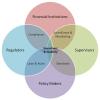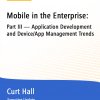Strategic advice to leverage new technologies
Technology is at the heart of nearly every enterprise, enabling new business models and strategies, and serving as the catalyst to industry convergence. Leveraging the right technology can improve business outcomes, providing intelligence and insights that help you make more informed and accurate decisions. From finding patterns in data through data science, to curating relevant insights with data analytics, to the predictive abilities and innumerable applications of AI, to solving challenging business problems with ML, NLP, and knowledge graphs, technology has brought decision-making to a more intelligent level. Keep pace with the technology trends, opportunities, applications, and real-world use cases that will move your organization closer to its transformation and business goals.
Recently Published
Mastering Complexity to Drive EA Productivity
Mastering Complexity to Drive EA Productivity
Testing Your Process
In his landmark blog post, "My agile testing project," Brian Marick provided a model for agile testing.
Big Data -- Does Size Matter?
While the term "Big Data" continues to encroach on the common vernacular, it's important to understand the drivers of the phenomenon, its possible value, and also its potential for misuse. Many of the "misuse" examples come from areas of privacy and ethics, but there is also the potential for misuse that is just bad business.













